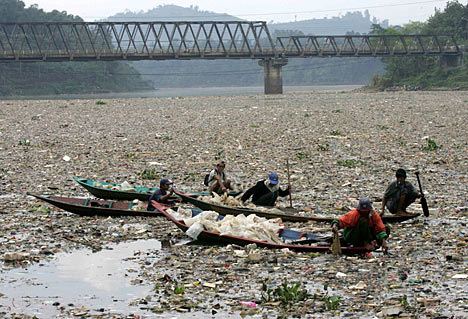Native name ᮝᮜᮥᮍᮔ᮪ ᮎᮤᮒᮛᮥᮙ᮪ Source Wayang-Windu | Length 300 km | |
 | ||
Similar | ||
Citarum (Sundanese: Walungan Citarum) is the longest and largest river in West Java, Indonesia It is also the third longest river in Java after Bengawan Solo and Brantas. It has an important role in the life of the people of West Java, as it supports agriculture, water supply, fishery, industry, sewerage, electricity, etc.
Contents
- Map of Sungai Citarum West Java Indonesia
- History
- Hydroelectric and irrigation dams
- Pollution
- Revitalization
- References
Map of Sungai Citarum, West Java, Indonesia
History
In Indonesian history the Citarum is linked with the 4th century Tarumanagara kingdom, as the kingdom and the river shared the same etymology, derived from the word "Tarum" (Sundanese for indigo plant). The earlier 4th century BCE prehistoric Buni clay pottery-making culture flourished near the river's mouth. Stone inscriptions, Chinese sources, and archaeological sites such as Batujaya and Cibuaya, suggest that the human habitation and civilization has flourished in and around the river estuaries and river valley as early as 4th century and even earlier.
Hydroelectric and irrigation dams
There are three hydroelectric powerplant dams installed along the Citarum: Saguling, Cirata, and Ir. H. Djuanda (Jatiluhur), all supplying the electricity for the Bandung and Greater Jakarta areas. The waters from these dams are also used to irrigate vast rice paddies in Karawang and Bekasi area, making northern West Java lowlands as one of the most productive rice farming areas.
The Jatiluhur Dam with a 3 billion cubic meter storage capacity has the largest reservoir in Indonesia.
The river makes up around 80 percent of the surface water available to the people who use it. Pollution has affected agriculture so much that farmers have sold their rice paddies for half their normal price.
Pollution
The river is heavily polluted by human activity; about five million people live in its basin. Textile factories in Bandung and Cimahi were major toxic waste contributors. More than 2,000 industries contaminate 5,020 sq miles of the river with lead, mercury, arsenic and other toxins.
On December 5, 2008, the Asian Development Bank approved a $500 million loan for cleaning up the river, calling it the world's dirtiest.
Revitalization
In November 2011, the river revitalization began, with an expected cost of Rp35 trillion ($4 billion) over 15 years. The revitalization is occurring from Mount Wayang through 8 regencies and 3 cities for a distance of 180 kilometers. The target for the first 3 years is to pick up 10.5 million cubic meters of sedimentation.
